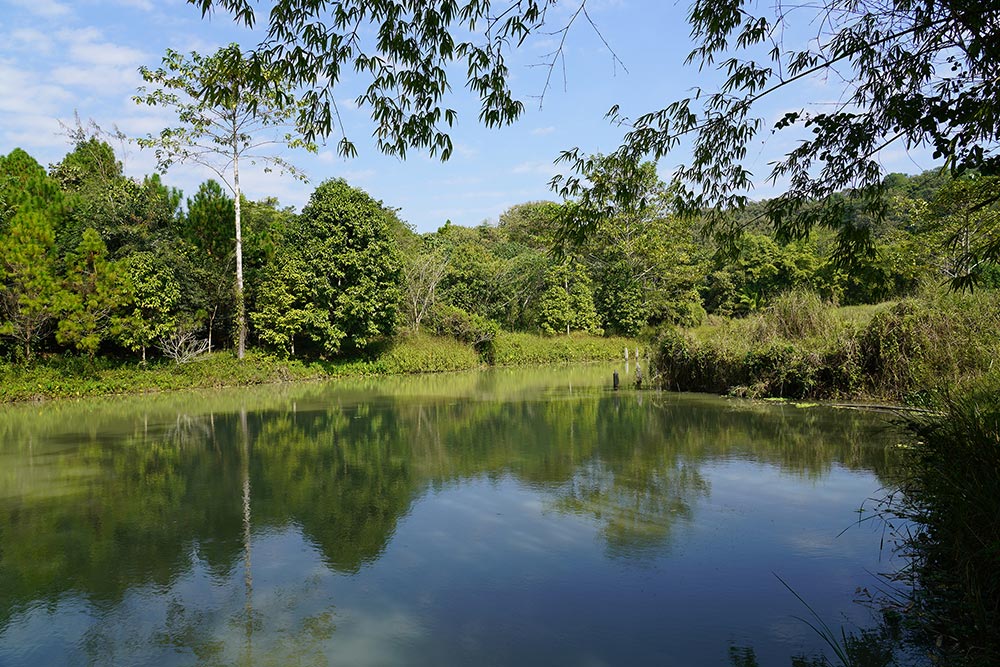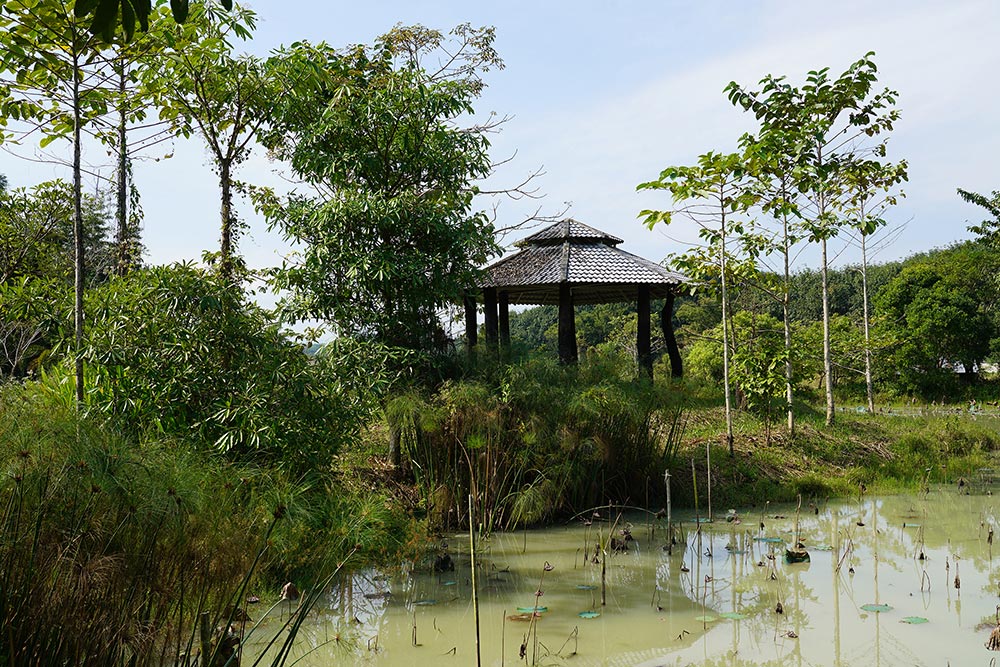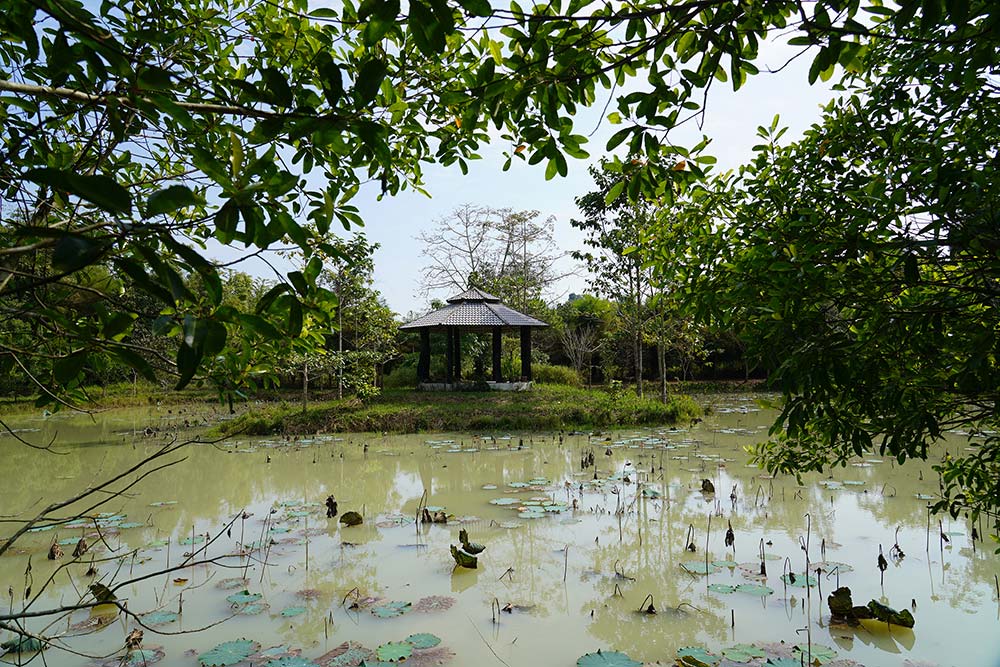‘Natasha’ in Nature
Angkrit Ajchariyasophon’s The Sanctuary is a 24-acre plot of land in Chiang Rai, Thailand, which the artist began tending in 2002. The land came to belong to his family in the 1990s, and before then it had been used for growing pineapple and other seasonal crops. Subsequently, Angkrit would learn from a neighbor that there had been a lotus field and wetlands prior to cultivation, and that the grounds had been a place for the gathering of waterfowl. Determined to return it to a more natural state, Angkrit began experimenting with planting trees and other flora, with hopes also of attracting its original fauna.
But how to begin such an endeavour? Masanobu Fukuoka’s The One Straw Revolution would prove to be a suitable guide and inspiration, as Fukuoka saw nature as a network of complex dependencies. Within his seminal manifesto, Fukuoka extolled a radical approach that he described as “do-nothing” farming. As he wrote, “If you want to get an idea of the natural fertility of the earth, take a walk to the wild mountainside sometime and look at the giant trees that grow without fertilizer and without cultivation. The fertility of nature, as it is, is beyond reach of the imagination.” 1 In nature, plants and trees do not grow in neat rows and organized plots. Fukuoka’s process involved not being involved – observing that modern agricultural techniques have become necessary only because a natural balance has been upset. With its principles of direct seeding, non-cultivation, and natural succession, Fukuoka’s strategy may be summarized as simply not getting in the way of nature.

Fig. 1: The garden path. It is late December, the weather in Chiang Rai is cool. The ground has some moisture left. The Lychee tree is still green, but the leaves of the Taiwan giant Bamboo have fallen and now cover the ground. The Acacia mangium stretches its branches to find the sunlight that is a source of its energy. Photo and caption by Angkrit Ajchariyasophon
While it is not Angkrit’s purpose to produce arable land, returning the land to nature would mean some measure of work, or at least the facilitation of growth. Amongst methods, Angkrit would employ Fukuoka’s practice of spontaneous seed broadcast – a carefree tossing of seeds roughly where soil conditions could provide them with the opportunity to take root. The process of transformation of land has thus taken the artist many years and much experimentation. It would seem his efforts have borne fruit – quite literally, too.

Fig. 2: By the pond. The Bur-flower tree rises straight, elegant and beautiful at the edge of the pond. Its neighbour is the white Champaka tree with its fragrant white flowers that stay all round the year. Behind them, upon a small hill, stand the three-needled pine and the large Monkey Fruit tree. Photo and caption by Angkrit Ajchariyasophon
Walking though The Sanctuary – which incidentally is not too simple a task because, following Fukuoka, the land is covered with enthusiastic undergrowth rather than human-friendly paths – we spot a cluster of recently-sprouted mushrooms amongst drifts of fallen leaves. Squatting down, Angkrit brushes aside these leaves to reveal white mycelium tendrils just underneath, and he invites me to feel this enriched soil. The humus is cool, friable, and clean to touch, and it emits a fresh and pleasing earthy scent.

Fig. 3: The octagonal sala. My father had bought numerous teak poles and kept them for many years. I used them to build an octagonal pavilion, just like in the Wuxia films that I enjoyed watching when I was young. Around it, I planted many of the Yang trees, which love water and these grew up quite quickly. Photo and caption by Angkrit Ajchariyasophon
Interest in fungal life seems to have bloomed in recent times, as warnings of climate crisis turn into reality. What may be more compelling is how this expanded knowledge of mycelia life might reorient our understanding of the world. For it is, indeed, entire worlds and systems that we are coming to fully understand. Even the assumption of ourselves as unified in form and consciousness is brought into question. Looking at our microbiomes, we are not singular organisms; we are ecologies.

Fig. 4: Sacred Lotus. In winter, the lotus flowers would wither throughout the pond, so as to store energy in their underground rhizomes. There, they wait for summer time to start new rhizomes from which large bouquets of white and pink flowers would blossom across the pond. Photo and caption by Angkrit Ajchariyasophon
The invocation of being and its experience in Natasha offers up the possibility of new knowledge and new understandings, of ourselves and of the world around us. A world in which we are perhaps not so distinct from the land and nature. From the study of mycelia, the tendency to frame the world in terms of human intention is a blind spot. As the fascinating exploration of fungi by Merlin Sheldrake reveals, “when we humanize the world, we may prevent ourselves from understanding the lives of other organisms on their own terms.” 2
June Yap is a curator based in Singapore and is currently the Director of Curatorial and Collections at the Singapore Art Museum. She wonders about trees ever so often. June.yap@singaporeartmuseum.sg